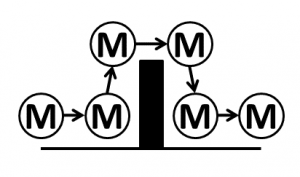 In medical training we have to learn about lots of things. That is one reason why it takes a long time to train a competent and confident clinician.
In medical training we have to learn about lots of things. That is one reason why it takes a long time to train a competent and confident clinician.
First, we learn the anatomy (structure) and the physiology (function) of the normal, healthy human.
Then we learn about how this amazingly complicated system can go wrong. We learn about pathology. And we do that so that we understand the relationship between the cause (disease) and the effect (symptoms and signs).
Then we learn about diagnostics – which is how to work backwards from the effects to the most likely cause(s).
And only then can we learn about therapeutics – the design and delivery of a treatment plan that we are confident will relieve the symptoms by curing the disease.
And we learn about prevention – how to avoid some illnesses (and delay others) by addressing the root causes earlier. Much of the increase in life expectancy over the last 200 years has come from prevention, not from cure.
The NHS is an amazingly complicated system, and it too can go wrong. It can exhibit a wide spectrum of symptoms and signs; medical errors, long delays, unhappy patients, burned-out staff, and overspent budgets.
But, there is no equivalent training in how to diagnose and treat a sick health care system. And this is not acceptable, especially given that the knowledge of how to do this is already available.
It is called complex adaptive systems engineering (CASE).
Before the Renaissance, the understanding of how the body works was primitive and it was believed that illness was “God’s Will” so we had to just grin-and-bear (and pray).
The Scientific Revolution brought us new insights, profound theories, innovative techniques and capability-extending tools. And the impact has been dramatic. Those who do have access to this knowledge live better and longer than ever. Those who do not … do not.
Our current understanding of how health care systems work is, to be blunt, medieval. The current approaches amount to little more than rune reading, incantations and the prescription of purgatives and leeches. And the impact is about as effective.
So we need to study the anatomy, physiology, pathology, diagnostics and therapeutics of complex adaptive systems like healthcare. And most of all we need to understand how to prevent catastrophes happening in the first place. We need the NHS to be immortal.
And this week a prototype complex adaptive pathology training system was tested … and it employed cutting-edge 21st Century technology: Pasta Twizzles.
The specific topic under scrutiny was variation. A brain-bending concept that is usually relegated to the mystical smoke-and-mirrors world called “Sadistics”.
But no longer!
The Mists-of-Jargon and Fog-of-Formulae were blown away as we switched on the Fan-of-Facilitation and the Light-of-Simulation and went exploring.
Empirically. Pragmatically.
And what we discovered was jaw-dropping.
A disease called the “Flaw of Averages” and its malignant manifestation “Carveoutosis“.
And with our new knowledge we opened the door to a previously hidden world of opportunity and improvement.
Then we activated the Laser-of-Insight and evaporated the queues and chaos that, before our new understanding, we had accepted as inevitable and beyond our understanding or control.
They were neither. And never had been. We were deluding ourselves.
Welcome to the Resilient Design – Practical Skills – One Day Workshop.
Validation Test: Passed.


